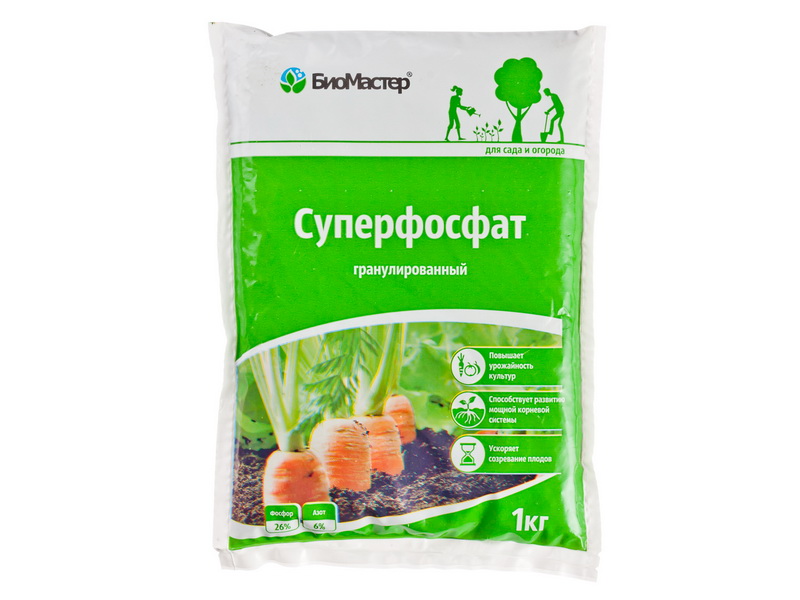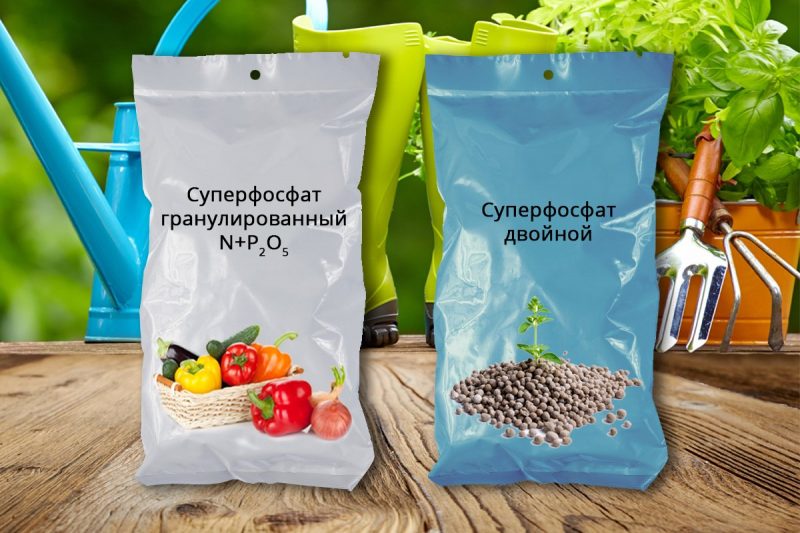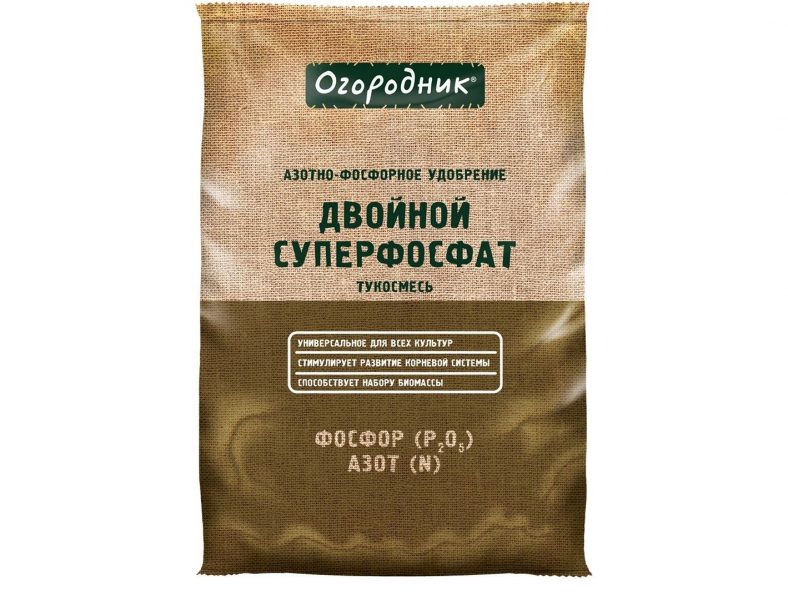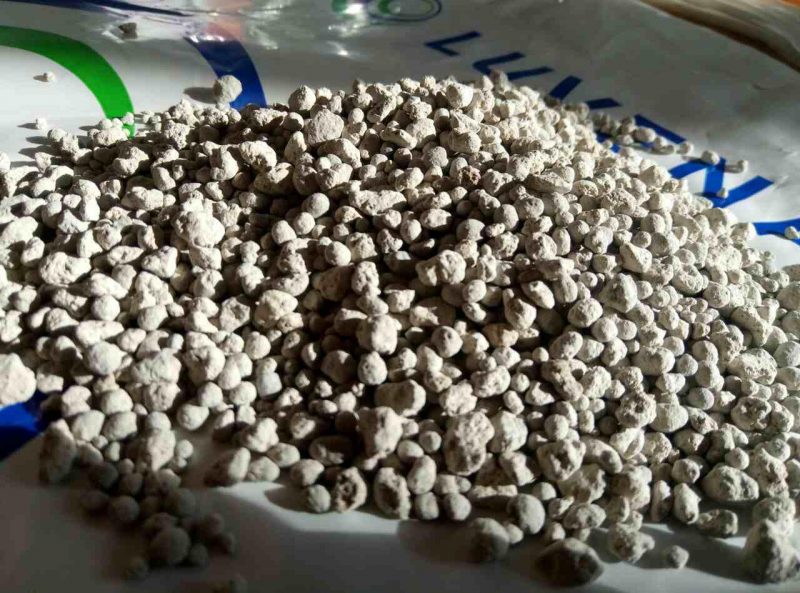Superphosphate has become widely used as a fertilizer for horticultural, vegetable crops, trees, shrubs and indoor plants. It is introduced into the ground in spring, summer and autumn. There are several varieties of this fertilizer that differ in composition.
Material Content:
Superphosphate: Composition of Fertilizer
The main component of the fertilizer is phosphorus. Its share is from 20 to 50%. Phosphorus oxide is in water-soluble form, which is a huge advantage of fertilizer. You can do liquid top dressing, as a result of which beneficial substances get to the roots of plants faster.

Depending on the species, phosphorus fertilizer may contain:
- nitrogen;
- sulfur;
- boron;
- molybdenum;
- calcium sulfate.
Phosphorus in the composition is most often in the form of phosphoric acid and monocalcium phosphate.
How to understand that plants need phosphorus?
All plants need phosphorus for normal development and growth. Without it, no culture will grow and bear fruit.
Signs of deficiency of this element:
- slow plant growth;
- chopping leaves;
- discoloration of the sheet plate to a bluish-green or blue hue;
- twisting and falling of leaves;
- violet-purple or red spots on the lower leaf plates;
- poor fruit setting during normal flowering;
- poor ripening, shedding of green fruits or their chopping.
Phosphorus is absorbed worse at low temperatures, so early seedlings often suffer from a deficiency of this substance.

Important.The greatest need for phosphorus is experienced by potatoes, cucumbers, carrots and cabbage. Less sensitive to deficiency are substances such as nightshade, radish, beets and onions.
With a sufficient amount of phosphorus, the plant enters the fruiting phase faster, yields increase, other beneficial macro- and microelements are better absorbed, the level of nitrates in vegetables and fruits decreases, and the taste characteristics of the fruits improve.
Also phosphoric fertilizers increase the immunity of crops, protect against diseases. Fertilizing slows down aging, contributes to the development of the root system.
Superphosphate species

The composition of the fertilizer depends on the type of superphosphate. There are such varieties: simple, double, granular, boric, ammoniated, magnesized, molybdenum. The dosage and composition of each species is different. When choosing a fertilizer, it is worth considering the needs of crops for nutrients.
Plain

Simple superphosphate contains:
- 10-20% phosphorus;
- 8-12% calcium;
- 10% sulfur;
- 8% nitrogen;
- 0.5% magnesium.
This non-concentrated water-soluble fertilizer is available in the form of gray powder or granules. It is less effective than other varieties, but costs much less.
Most often, simple superphosphate is used by farmers. Suitable for feeding legumes, cereals, bulbs, as well as potatoes, beets, carrots, turnips, radishes and other crops.
Double
Double superphosphate is a concentrated water soluble fertilizer. It contains a large amount of water-soluble calcium, so beneficial substances are better absorbed by plants.

Fertilizer composition:
- 40-46% phosphorus;
- 20% nitrogen;
- 6% sulfur;
- calcium sulfate;
- zinc;
- copper;
- iron;
- boron;
- manganese;
- molybdenum.
Fertilizer is suitable for all soils and plants.
Granulated
It is made from simple superphosphate. The powder is pressed and converted into 3-4 mm granules.

Granular superphosphate is more convenient to apply. It dissolves more slowly in soil, but is in a form more accessible to plants.
The composition includes up to 50% phosphorus and 30% calcium sulfate. This nutrient content is important for cruciferous, cereal, bean and bulb crops.
Ammoniated
This is a granular nitrogen-phosphorus fertilizer. In addition to its main components, it includes sulfur (about 12%) and calcium sulfate (up to 55%).

Fertilizer is most suitable for oilseed and cruciferous plants, which need not only high doses of phosphorus, but also sulfur. It does not acidify the soil, therefore it is suitable for acidic soils. Another significant advantage is the good digestibility by nitrogen plants.
Ammonized superphosphate dissolves in water, so it is suitable for root and foliar top dressing.
What soil to use?
Fertilizer is suitable for application to any type of soil, but it brings the greatest benefit to plants that grow on neutral or alkaline soils. With increased acidity, superphosphate is converted to iron or aluminum phosphate. These compounds are not available for plant nutrition, therefore, will not bring benefits.

Often, cheap fertilizers contain impurities that contribute to the formation of non-digestible phosphates. For acidic soil, it is necessary to choose only expensive phosphate fertilizers or pre-deoxidize the soil with lime or wood ash. On 1 sq. M. plot you need to make 200 g of ash and 0.5 kg of lime.
Important. Phosphoric fertilizer should be applied no earlier than a month after deoxidation of the soil.
You can safely use superphosphate on acidic soil as a preventive feeding. Phosphorus will be available for plants next year.
Instructions for use
Superphosphate should be used according to the doses indicated in the instructions. It is not necessary to fill the fertilizer into the soil, it is enough to scatter it on the surface of the soil before rain.
In the garden
The use of superphosphate can be made in the following ways:
- apply dry before planting;
- add to compost, humus, manure;
- scatter on the surface of the soil immediately before the spring or autumn digging of beds;
- prepare an aqueous solution and water the plants under the root;
- sprinkle on the surface of the soil during top dressing.
It is possible to use phosphorus fertilizer in the garden in the spring, summer and autumn, but preference should be given to autumn top dressing.
Important. The highest dose of phosphorus should be introduced during the flowering and fruiting period.
The superphosphate application rates are as follows:
- as a soil fertilizer - 40-50 g / m2 (on poor soils, the dosage can be increased to 100 g / m2);
- as a top dressing - 55-70 g / m2;
- for fertilizing seedlings when planting - 500 g in the planting pit;
- root dressing of trees - 40-70 g;
- planting potatoes - 3-4 g per well or 20 g / m2 plot;
- tomato fertilizer - 20 g for each plant (in spring and summer before flowering).
For vegetable crops, simple superphosphate is preferably used simultaneously with potash and nitrogen fertilizers, double and granular - with potash fertilizing.
Important. Instructions for use state that superphosphate cannot be used simultaneously with urea, ammonium nitrate, lime and chalk. Between dressings should be a minimum of 7 days.
For seedlings, root dressing is more suitable with simple superphosphate, but fertilizer can be applied when digging soil in a greenhouse at the rate of 100 g per 1 sq. M. The solution is prepared as follows: 20 g of superphosphate must be diluted in 3 l of water, then diluted with 10 l of water. Pour under the root, the norm is 30-50 ml per plant.
For indoor plants
Superphosphate can be used for indoor flowers, especially for blooming. With a deficiency of phosphorus, flowering will be sparse, and the plant itself will look unhealthy, slowly add to growth.

Before flowering in spring, it is necessary to make a solution of superphosphate, potassium salt and ammonium nitrate. A 1 liter pot will require 70 ml of liquid fertilizer.
Fertilizing repeat 1-2 times a month until the onset of dormancy. Slow-growing plants and palm trees should be fed once a quarter.
Superphosphate extractor
In order for phosphorus to be better and faster absorbed by plants, fertilizer should be applied not in a dry form, but in the form of an aqueous solution. But there is a problem. Phosphorus fertilizers are poorly soluble in water. To get the hood, you need exposure to high temperatures.
Granular fertilizer must be filled with boiling water. For cooking, you need 300 g of superphosphate and 3 l of water. The granules must be thoroughly mixed, although they will not completely dissolve, but will turn into slurry.
It will turn out a concentrate. It cannot be used in its pure form. To feed plants, you need to dilute 100 ml of concentrate in 10 l of water. You can add 0.5 l of ash solution and 20 g of nitrogenous fertilizer.













